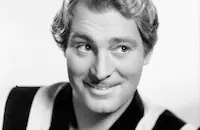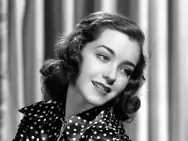Irene

Brief Synopsis
Cast & Crew
Herbert Wilcox
Anna Neagle
Ray Milland
Roland Young
Alan Marshal
May Robson
Film Details
Technical Specs

Synopsis
Irene O'Dare, an upholsterer's assistant, meets wealthy Don Marshall while she is measuring chairs at the Herman Vincent estate in Long Island. Don becomes enchanted by Irene, and decides to promote her career by anonymously buying Madame Lucy's, an exclusive Manhattan dress shop, thus insuring her a job as a model. Don installs Mr. Smith as the manager of the shop, and soon Irene is selling dresses to Mrs. Herman Vincent and other socialites. Her success earns the enmity of the other models while also renewing the attentions of Bob Vincent, scion of the wealthy Vincent family. In order to promote the shop's dress line, Mr. Smith arranges for his models to be invited to a society ball held at the Vincent estate. At the ball, Irene causes a stir when she is mistaken for Irish nobility, thus giving Mr. Smith an idea for further publicizing his collection. Exploiting Irene's mistaken identity, Mr. Smith installs her in a Park Avenue apartment and supplies her with diamonds and furs as she is escorted around town by Bob. After gossip columnist 'Biffy' Webster gets a tip about Irene from an envious model, he prints a snide innuendo about how her expensive apartment and clothes are being paid. Incensed, Irene goes to confront Madame Lucy and learns that Don is the real owner of the shop. Feeling angry and betrayed, Irene consents to marry Bob, but on the eve of their wedding, a disconsolate Bob realizes that he loves his former sweetheart, Eleanor Worth, while Irene realizes that she loves Don. All ends happily as the couples realign themselves.

Director

Herbert Wilcox
Cast

Anna Neagle

Ray Milland

Roland Young

Alan Marshal

May Robson

Billie Burke

Arthur Treacher

Marsha Hunt

Isabel Jewell
Doris Nolan
Stuart Robertson
Ethel Griffies
Tommy Kelly

Juliette Compton
Roxanne Barkley

Louis Jean Heydt

Nella Walker
Martha Tilton
Dorothy Dandrige
Vivian Dandridge
Hattie Noel
Syd Saylor
Crew
Aida Broadbent
Anthony Collins
Anthony Collins
Bill Dorfman
Syd Fogel
Joseph Mccarthy
Russell Metty
Alice Duer Miller
Lloyd Richards
Gene Rose
Darrell Silvera
Edward Stevenson
Harry Tierney
Douglas Travers
Richard Van Hessen
Vernon Walker
Merrill G. White
Herbert Wilcox
Elmo Williams
L. P. Williams

Videos
Movie Clip


Film Details
Technical Specs

Award Nominations
Best Score
Articles
Irene
London-born Neagle, with the help of Herbert Wilcox, the producer-director who became her husband, became England's leading screen star in the 1930s and '40s. During the latter decade, for seven years she was voted the United Kingdom's best-loved film performer. Neagle and Wilcox made 32 pictures together. During World War II they worked together on several Hollywood productions including Irene.
Neagle plays Irene O'Dare, an Irish girl of humble origins who takes a job as shopgirl at an expensive boutique and finds herself being courted by its handsome owner (Ray Milland). Also competing for Irene's attention is a young socialite (Alan Marshal). Assigned to model at a charity ball, Irene ruins the gown she is to wear and substitutes a quaint blue dress of her mother's -- and it creates a sensation. Misidentified as the niece of Ireland's Lady O'Dare, Irene capitalizes on the false identity to promote fashions from the boutique, until a newspaper columnist uncovers the truth.
Anthony Collins was nominated for an Oscar® for his scoring of the Neagle film, which includes several songs from the original Broadway score including "Castle of Dreams," "Worthy of You," "You've Got Me Out on a Limb," "There's Something in the Air" and "Alice Blue Gown." The latter number was shot in Technicolor, while the remainder of the movie is in black and white. The bright red of Neagle's hair, not distinguishable in black and white, often drew applause in theaters during this sequence. "Alice Blue Gown" is reprised in a production number that's presented as an installment of "Rex Gordon's Moviebone News" (kidding the Movietone News shorts that were popular at the time). Among the performers are the Dandridge Sisters, one of whom was 17-year-old Dorothy Dandridge.
Lux Radio Theatre presented a version of Irene starring Jeanette MacDonald and Regis Toomey in June 1936. In 1971 Irene was revived as a stage vehicle for Debbie Reynolds, with John Gielgud (later replaced by Gower Champion) as director, and Peter Gennaro (who had choreographed Reynolds in the 1964 film version of The Unsinkable Molly Brown) staging the dances. The show opened on Broadway on March 13, 1973, as the first attraction of the new Minskoff Theatre, where it ran for 605 performances, with Jane Powell eventually replacing Reynolds. It again was taken on tour, by both Reynolds and Powell.
Producers: Herbert Wilcox, Merrill G. White (Associate)
Director: Herbert Wilcox
Screenplay: Alice Duer Miller from play by James H. Montgomery
Cinematography: Russell Metty
Original Music: Harry Tierney
Editing: Elmo Williams
Art Direction: Lawrence P. Williams
Costume Design: Edward Stevenson
Principal Cast: Anna Neagle (Irene O'Dare), Ray Milland (Donald "Don" Marshall), Roland Young (Mr. Smith), Alan Marshal (Robert "Bob" Vincent), May Robson (Granny O'Dare), Billie Burke (Mrs. Herman Vincent), Arthur Treacher (Bretherton, the Butler), Marsha Hunt (Miss Eleanor Worth), Isabel Jewell (Jane McGee).
BW & Color-101m. Closed captioning.
by Roger Fristoe

Irene
Quotes
I understand discretion is your middle name.- Donald 'Don' Marshall
Mr. Marshall, if butlers told all they knew, society would be a shambles.- Bretherton, the Butler
Trivia
The musical comedy "Irene" opened on stage in New York City on 1 November 1919.
Notes
Marionettes of Anna Neagle and Ray Milland appear throughout the opening credits and briefly in the end credits after the stars names reappear. Although the names of Martha Tilton, Hattie Noel and The Dandridge Sisters are not in the opening or closing credits, they appear as written credits of the "Moviebone Newsreel," which is part of the musical revue that Irene attends. While most of the film was in black and white, the lengthy sequence of the night of the ball is in color, beginning with the opening shot of Neagle as "Irene O'Dare" in the "Alice Blue Gown" and ending the next day when a title card announces "The grey light of morning." Anthony Collins received an Academy Award nomination in the Music (Scoring) category.
According to a news item in Hollywood Reporter in June 1934, M-G-M was negotiating for the rights to the play at that time. A silent film based on James H. Montgomery's musical-comedy was produced by First National in 1926, starring Colleen Moore and directed by Alfred E. Green (see AFI Catalog of Feature Films, 1921-30; F2.2731). In 1936, Jeanette MacDonald starred in a Lux Radio Theater version of the play.














